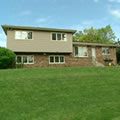Budgets: Pooling Resources

Before they sink themselves in the deep end, a couple checks in with Suze Orman on their beautification budget: "We just bought a $275,000 house, in a new development, with very little landscaping and with neighbors very close by. Because we live in a warm climate, we can barbecue and dine outside most of the year, and we want to build a stone patio and pergola and put up a fence masked by thick greenery. We're also imagining pots of flowering plants and solid outdoor furniture. How much is it reasonable to budget for such a project? (We're thinking about building a pool, too.)"
I think that enhancing your outdoor space is a smart move because you live in an area where you can spend a lot of time enjoying the fresh air. You can essentially create a whole new room for your house. But your approach to your backyard project is a bit backward. You've given me a wish asking me what it might cost. You should be thinking only about what you can afford. - Set your budget first, and then figure out how big a project that amount will cover. When figuring out your budget, make sure you allow for the hidden costs of your project. You may, for example, have to pay for certain building permits. It also sounds as if you may need to consult with a landscape architect on the plans. And given that you're in a warm-weather area and want a lot of flowers and foliage, you'll probably end up having an underground sprinkler system installed. What's more, depending on where you live—and how often your property value is assessed—the improvements could boost your taxes.
- The primary goal is to avoid overextending yourselves financially. Bombarded as we are with ads on television and offers in the mail, you may be tempted to take out a home-equity loan (HEL) to finance the entire cost of your project. Yes, the interest payments on a HEL are deductible (up to $100,000), but you still end up paying money, my friends. At today's low rates, you're looking at getting 30 cents or so back as an interest deduction for every dollar you spend. That means you still have to spend 70 cents to "save" 30 cents. Remember, every loan on your house means that your home is the collateral. If you fall behind on your HEL, your lender may be able to take over the house—all because of a $10,000 or $20,000 loan for a new backyard.
- Before you touch a thing in your yard, I want you to get some estimates of what it will cost not just to build but also to maintain this project. You might be able to put in a fence, a patio and plantings for $10,000 or so. But how much will it cost you every year for the gardener, the taxes, etc.? Then there's the upkeep. Do you intend to do all the maintenance work yourselves? Or will you need to budget for a gardener? And if you build that pool, you could wind up drowning in expenses. Hiring a professional pool service could run you $50 to $100 a month. You'll also be paying for extra electricity to run the pool pumps. Add in pool heating, and you're looking at some serious monthly outlays.
- Since you live in a new development, here are two more questions for you to ponder. Has the development sold out, or are you one of the pioneers? If sales are a bit slow and you anticipate moving in the next few years, you obviously need to be careful about spending a lot on your house. Also, does the $275,000 you paid for the place put you at the low end or the high end of the scale for your development? The advice I gave in my first answer applies equally to you: While it's reasonable to improve your home, you don't want the additions to make your house the Taj Mahal on a block of tract houses.



